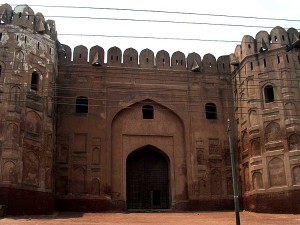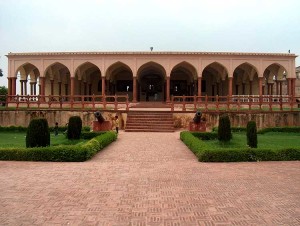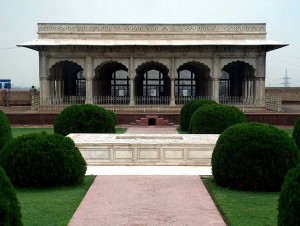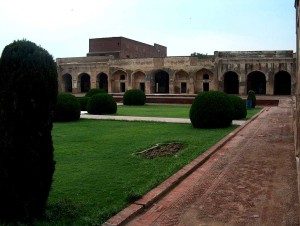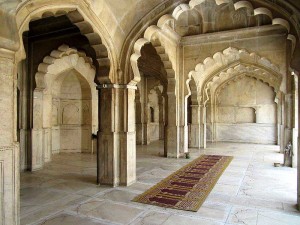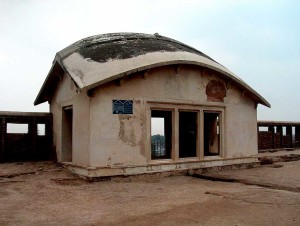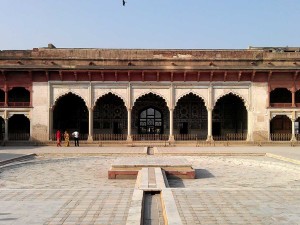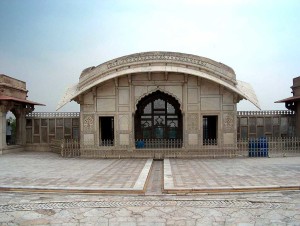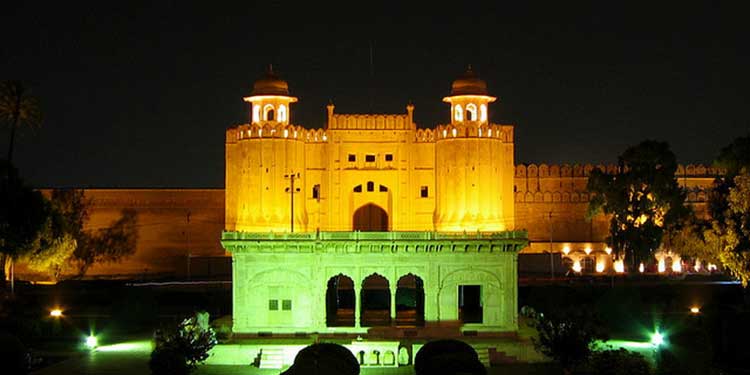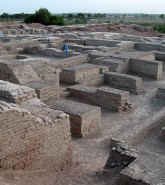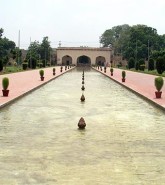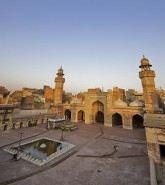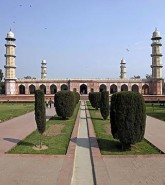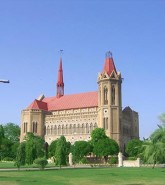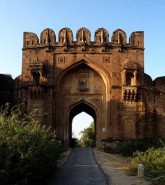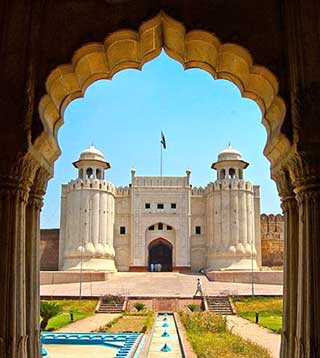
Lahore Fort also known as Shahi Qila is located in north-western corner of the historical city of Lahore. Though irregular in scheme the fort measures about 427 meters east-west and 335 meters north-south excluding the fortification wall added later during the Sikh rule of Maharaja Ranjit Singh (1799 - 1839 A.D).
The chequered history of the fort is a living witness of the zenith and nadir of the Mughals, the Sikhs and the colonial rulers. The art of the fort building is reflects a series of monuments from Emperor Akbar (ruled: 1556 - 1605) to the Aurangzeb (ruled: 1658 - 1707 ).
The court of Emperor Akbar occupies the south-east area of the fort but most of the building have been extinct and the Masti / Akbari is still facing the Maryam Zamani Mosque. The northern half of the fort with its architectural beauty is divided into six quadrangles; from Akbari Gate to Shish Mahal.
Lahore Fort and Shalamar Garden are enlisted as World Heritage Sites in 1981 by UNESCO (United Nations Educational, Scientific and Cultural Organization). Presently the administrative control of Lahore fort and Shalamar Garden lies with Punjab Government, under Archaeology and Tourism Department of Punjab. A reasonable amount was allocated by Punjab Government in the year 2005-6, for the restoration and conservation of these two monuments.
Notable Buildings and Structures of Lahore Fort:
Akbari Gate / Eastern Gate
It was built by Emperor Akbar in about 1566 A.D. It was later on called the Masti a corruption of the word in local version Maseet (transformation in English: Mosque). The Empress of Akbar built a mosque outside this gate in 1614 A.D that still exists in good condition. The fort of Akbar’s time had two gates including Masti Gate. The other gate was later replaced by Alamgiri gate in 1673 A.D.
Alamgiri Gate
Build by Emperor Aurangzeb Alamgir (ruled: 1658 - 1707 A.D) in 1673 in the west of the fortification wall, it opens in the Hazoori Bagh (Hazoori Garden). It shows a military and pleasing blend of strength, grace and grandeur as well. It has two semi-circular bastions decorated with lotus petal designs at the base.
Diwan-e-Aam (Hall of Public Audience)
Shah Jahan in his fourteenth year of his rule (year 1642 A.D) ordered to construct the hall of forty pillars and its construction was completed in under the supervision of Asif Khan (brother of Nur Jahan, the empress of Shah Jahan’s father, Jahangir). Diwan-e-Aam was collapsed when Sher Singh (son of Ranjit Singh) bombarded Lahore Fort by light guns fighting against Chand Kour the widow of Kharak Singh, the elder son of Ranjit Singh. The British rebuilt it after their occupation of the fort in 1849 A.D. The marble work in the state balcony in this area appears to be the earliest structural existing at Lahore Fort.
Jahangir’s Quadrangle
Its construction was started by Akbar but completed by Jahangir in 1617-18 A.D. Having been built with the cost of seven lacs (Seven Hundred Thousands) of rupees. Its features reflect Hindu temple architecture referring the Akbar’s policy of tolerance. On the east and west row of dalans (porticos) encircle it and the red sandstone facade of dalans reflects Hindu art enriched with carved columns and elaborated brackets showing animal figurines. In the center of the north side , there is Jahangir’s sleeping room currently being used as Mughal Museum / Gallery. There is also a garden situated in Quadrangle having square marble Mahtabi (platform) in the middle for the use of musicians and dancing girls.
Diwan-e-Khas (Hall of Special Audience)
It was constructed by Shah Jahan in 1645 A.D. It is an arched pavilion sheerly built in semi-chaste marble and its parapet was fashioned with pietra dura work (The art of inlaying semi-precious stones into white marble). There are excellent carved marble screens that are skillfully designed. In the middle of the pavilion a foundation with marble cistern enhanced its royal beauty.
Khwabgah (Sleeping Chamber) of Shah Jahan
It was built by Shah Jahan in 1633 A.D and the work of its construction was entrusted to Wazir Khan (the founder of Wazir Khan Mosque). It existed on the southern end of Shah Jahan’s Quadrangle. It comprises five chambers laid in one row that are exceptionally brilliant with the perforated screen dressed in white marble.
The incised work known as Ghalib Kari in Urdu and stucco tracery on the arches of this monument are the main features of this building. Some fresco paintings are also visible interior of this sleeping chamber.
Makateeb Khana (Reception Chamber)
In the forecourt of Jahangir’s palace and in the north-west corner of Diwan-e-Aam, it was built in 1617-18 A.D during the rule of Emperor Jahangir (1605 - 1627 A.D). It was used as the entrance gate by Muharrirs (Clerks). There the carved Persian inscription on marble slab relates to the construction under the supervision of Mamur Khan.
Moti Masjid (Pearl Mosque)
It is one of those two mosques built in chaste marble by Emperor Shah Jahan. The second one was built at Agra Fort in 1654 A.D. Aurangzeb also constructed a mosque of the same type at Red Fort Delhi in 1662 A.D. They are all titled as Pearl Mosque because of their outlook imbued with white marble. The Sikh rulers in Punjab used the Pearl Mosque at Lahore Fort as treasury and named it as Moti Mandir (Pearl Temple).
Lal Burj (Watch Tower)
The three storied summer pavilion of Lal Burj lies adjacent to Diwan-e-Khas and stands in the corner of Shah Jahan’s Quadrangle. The two stories (not the topmost, that was Sikh addition) together with the basement chambers are the beautiful work of Emperor Jahangir and Shah Jahan. The exterior is beautifully furnished with tile mosaic and filigree work, while the interior is a model of colorful fresco paintings.
Kala Burj (Watch Tower)
This building also used to serve as a summer pavilion and it is similar to Lal Burj in many respects. It occupies north-west corner of Khilwat Khana (Place of Isolation). The topmost storey of the the roofs belongs to British period, being used as bar. The Chhajja (eave) of the Kala Burj is built with interlocked brick work.
Hammam-e-Shahi (Royal Bath)
It was built by Shah Jahan in about 1633 A.D. It lies adjacent to Shah Jahan’s Khwabgah (Sleeping rooms of Shah Jahan) on the west. Thus it is patterned on Turkish style, so it comprises Jama Khana (Dressing and undressing room). The bath also had the facility of warm and hot water.
Paien Bagh (Ladies Garden)
The main feature of the Mughal Garden is the provision of paved paths for the walkways. Paien Bagh was built for royal ladies to sustain their health. There is also a water basin in the middle of the spacious platform built built in brick work.
Hathi Paer (Elephant Stairs)
Built by Emperor Shah jahan in 1631-32 A.D, it was meant for elephants carrying the royalty from and to the palace. So for the purpose, it starts Hathi Paer gate and ends on the outer courtyard of Shish Mahal. It has 58 low and broad steps measuring 216 inches in length and 18 feet and 8 inches in width.
Khilwat Khana (Place of Isolation)
It was built by Shah Jahan in about 1633 A.D. It is located in the northern portion of the Paen Bagh. The plinth and door frames of the pavilion are of marble but its roof is curvilinear type.
Ath Darra (A building having eight openings)
Maharaja Ranjit Singh, who ruled over Punjab, built it and used it for Kacheri (court). The gilt frescos paintings on its northern wall made by Maharaja Ranjit’s court artists reflect the style of Kangra School of Painting all around that speak loudly of its relation with Sikh period. Its ceiling is embellished with beautiful woodwork. The magnificent woodwork with beautiful mirror work is the recent restoration made by the Department of Punjab Archaeology. This monument was constructed at the place of the original entrance of Shish Mahal.
Shish Mahal (Palace of Mirrors)
This celestial looking mirror palace is located in north-west corner of the fort. It is one of the most majestic palaces of the Mughal period. It was constructed under the supervision of Asif Khan for Emperor Shah Jahan in 1631-32 A.D. There is a spacious hall in front with several rooms behind and on the sides. The palace formed the Harm (Ladies portion) of the fort. The rear chamber houses a marble screen beautiful carved out in tendril, floral and geometrical patterns.
The chief features of Shish Mahal are
- Gillt work (placing of pure gold)
- Pietra dura work (inlay of semi-precious stones into white marble)
- Marble perforated screens
- The Aiena Kari (convex glass mosaic work) with Monabat Kari (stucco tracery)
The versatility of variegated marble stone slabs (Sang-e-Musa, Sang-e-Abri, Sang-e-Badal) added the beauty of spacious courtyard in front of the palace. The shallow water basin is constructed in the center of Mahal that comprises four jet fountains. The other building are connected with basin through the four water channels on each side.
Bangla Naulakha (Naulakha Pavilion)
The name is after the cost of rupees nine lacs, spent for its construction. This edifice is renowned for its entirely delicate and minute pietra dura work, wrought in semi-precious stone such as Agate, Jade, Lapis-Lazuli, and Goldstone etc. The ceiling of the pavilion is decorated with looking glass and wooden trellis. This splendor small pavilion is generally placed as one of the best architectural accomplishment of Mughal era.
Pictured Wall
The gorgeous being elaborated and vivid mosaic decoration in pleasing colors on plaster base is the main feature of the wall that was commenced by Emperor Jahangir in 1624-25 A.D but accomplished by Shah Jahan in 1631-32 A.D. The wall measuring nearly 457 meters in length and 17 meters in height, is the most representative relic of Mughal period. It mainly reflects the sports and pastimes of Mughal Emperors, nevertheless it exposes a variety of geometrical and floral patterns. The human figures on this presents a clear vision of the various styles of the mosaic are adorned in some hunting, fighting, dancing and mythological scenes. This art known in Persian as Kashi Kari because it originated from Kashan the city of Persia (Iran).
Lahore Fort Museums
The Lahore Fort showcases three small site museums within the area of Lahore Fort.
1. Mughal Gallery
It is located in Jahangir’s Quadrangle. The Mughal Gallery provides with historic manuscripts, coins, miniature paintings and some specimens of Persian and Arabic calligraphy etc.
2. The Armory Museum
Located in Dalan-e-Sang-e-Surkh of Moti Masjid, the Armory Museum showcases the arms and armoury captured by British during the Sikh battles. It contains items like swords, daggers, arrows, spears, helmets, guns, and pistols etc.
3. Sikh Gallery
The Sikh Gallery is located in the Haveli of Rani Jindan. It houses the Princess Bamba collection belonging to Ranjit Singh. Princess Bamba was the granddaughter of Maharaja Ranjit Singh. This gallery carries a rare collection of oil paintings. It also includes some beautiful paintings by European artists. Bamba lived in England but died and buried in Lahore in 1958 A.D.
Visitors Guide
Entrance
The entrance to Lahore Fort for general public nowadays is through Hathi Gate. Here is situated the booking office for entry ticket.
Timings
The fort is open to public all the seven days of the week observing the following timings.
Summer: 1st April to 30th September, from 7:30 hrs to half an hour before sunset.
Winter: 1st October to 31st March, from 8:30 hrs to half an hour before sunset.
Museum and Galleries Timings
There is no extra charge for visiting the museum or galleries in the fort but they open according to the following timings:
Summer:
- 8:30 to 12:30 hrs
- 14:30 to 17:30 hrs
Winter: 9:00 to 16:00 hrs
Canteen:
Drinking water is available near PIATR Campus. While for drinks and snacks etc, a canteen situated south of Diwan-e-Aam that remain opened throughout the visiting hours.
Toilets:
Toilets for visitors are located in front of Diwan-e-Aam area.
Note: The timings, entrance point and location of canteen may not be same (as mentioned in article) when you visit the fort. The administration of Lahore Fort can make changes to timings, entrance place etc.
Quick Facts
UNESCO World Heritage Site
- According to available historical information the origin of the fort is obscure. However, the existing foundation of Lahore Fort was laid by Emperor Akbar in 1566 A.D.
- The fort was enlisted as a World Heritage Site by UNESCO in 1981.
- The total covered area of the fort is about 20 hectares.
